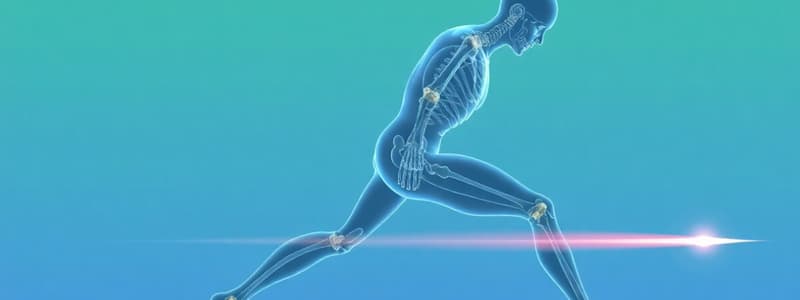Podcast
Questions and Answers
What is the resultant force in a situation where a 25-pound traction force acts upwards while a 10-pound weight acts downwards?
What is the resultant force in a situation where a 25-pound traction force acts upwards while a 10-pound weight acts downwards?
- 15 pounds (correct)
- 25 pounds
- 35 pounds
- 10 pounds
Which component of a muscle force is responsible for causing torque or rotation at a joint?
Which component of a muscle force is responsible for causing torque or rotation at a joint?
- Resultant force
- Y component force (correct)
- X component force
- Joint reaction force
What does the term 'joint reaction force' refer to?
What does the term 'joint reaction force' refer to?
- The opposite force to the resultant force at a joint (correct)
- The gravitational pull on a joint
- The total weight supported by a joint
- The force applied by a muscle at a joint
What two elements are essential for quantifying a vector?
What two elements are essential for quantifying a vector?
In the context of vector resolution, what happens when the line of pull runs through the axis of rotation?
In the context of vector resolution, what happens when the line of pull runs through the axis of rotation?
Which statement best describes spatial orientation in relation to a vector?
Which statement best describes spatial orientation in relation to a vector?
How does changing the angle of a joint affect muscle forces during exercise?
How does changing the angle of a joint affect muscle forces during exercise?
How can vectors be classified in terms of their direction?
How can vectors be classified in terms of their direction?
What does the point of application of a vector refer to?
What does the point of application of a vector refer to?
In a clinical setting, gravity acts on which part of the body segment?
In a clinical setting, gravity acts on which part of the body segment?
What happens to the torque when the knee is flexed and the foot is brought up?
What happens to the torque when the knee is flexed and the foot is brought up?
In a first class lever, where is the axis of rotation typically located?
In a first class lever, where is the axis of rotation typically located?
What is the primary mechanical advantage of flexing the knee during a lift?
What is the primary mechanical advantage of flexing the knee during a lift?
Which class of lever is characterized by the internal moment arm being greater than the external moment arm?
Which class of lever is characterized by the internal moment arm being greater than the external moment arm?
What is the torque calculated when the leg is fully extended at 24 pounds and 15 inches?
What is the torque calculated when the leg is fully extended at 24 pounds and 15 inches?
Which scenario exemplifies a second class lever in the human body?
Which scenario exemplifies a second class lever in the human body?
Which factor does NOT significantly influence muscle force production in manual muscle testing?
Which factor does NOT significantly influence muscle force production in manual muscle testing?
What is the effect of reducing the external moment arm during lifting exercises?
What is the effect of reducing the external moment arm during lifting exercises?
Flashcards are hidden until you start studying
Study Notes
Biomechanics: Vectors
- A vector is a force represented by an arrow, defined by magnitude (size, indicated by arrow length) and direction (arrowhead).
- Four factors describe a vector completely: magnitude, direction, spatial orientation (shaft position; positive vectors point up/right, negative down/left), and point of application (where the arrow base contacts the body; gravity acts on the center of mass).
- Vectors can be combined; the sum of forces is the resultant force. Joint reaction force is the equal and opposite force to the resultant force (Newton's Third Law).
- Vector resolution breaks down a force into its components (e.g., X and Y components). The Y component creates torque (rotation), while the X component causes compression or distraction (depending on joint angle). Torque requires a force and a moment arm (perpendicular distance between axis of rotation and line of pull). The X component produces no torque if its line of pull passes through the axis of rotation.
- Joint angle alters the balance between torque and compression/distraction, impacting muscle force requirements.
Biomechanics: Levers
- A lever is a rigid bar pivoting around a fixed point (axis of rotation) to transmit force; bones function as levers to convert linear force to rotary torque.
- Three lever classes:
- First-class lever: Axis of rotation between opposing forces (e.g., seesaw, head); mechanical advantage can be <1, >1, or =1.
- Second-class lever: Axis of rotation at one end; internal force arm > external force arm, resulting in mechanical advantage >1 (e.g., standing on tiptoes, wheelbarrow).
- Third-class lever: Axis of rotation at one end; external force arm > internal force arm, mechanical advantage <1 (most common in the musculoskeletal system; e.g., bicep curl, chopsticks).
- Mechanical advantage (MA) = internal moment arm length / external moment arm length (or force arm length / resistance arm length). MA > 1 requires less muscle force; MA < 1 requires more.
Lever Systems in the Human Body
- Three classes of levers exist in the human body: first, second, and third class.
- First-class levers have the axis of rotation between the muscle force and the resistance force. An example is the head balanced on the neck.
- The mechanical advantage (MA) in a first-class lever can be greater than or less than 1 depending on moment arm lengths. A MA > 1 means less muscle force is needed.
- Example: Head weighing 10.5 pounds, with a MA of 1.25, requires only 8.4 pounds of muscle force.
- Second-class levers always have a MA greater than 1, meaning the muscle requires less force than the resistance. The resistance is between the axis and the force.
- Example: Gastrocnemius/soleus muscles lifting the body weight (150 pounds). MA of 4, meaning only 37.5 pounds of muscle force needed.
- Third-class levers have a MA always less than 1, requiring significantly more muscle force than the resistance. The muscle force is between the axis and resistance. This is the most common type in the human body.
- Example: Lifting a 15-pound weight may require 105 pounds of muscle force due to a MA of 0.143.
- Examples of third-class levers in the body include the biceps brachii at the elbow, quadriceps at the knee, and supraspinatus at the shoulder.
Altering Mechanical Advantage
- Therapists can alter the external moment arm, for example during manual muscle testing by changing hand placement on a limb.
- Surgeons can alter the internal moment arm length by repositioning a muscle's tendon. Increasing this length increases torque.
- Increasing the internal moment arm length improves torque per level of muscle force but causes:
- Reduced angular displacement of the joint.
- Reduced velocity of movement.
Studying That Suits You
Use AI to generate personalized quizzes and flashcards to suit your learning preferences.




